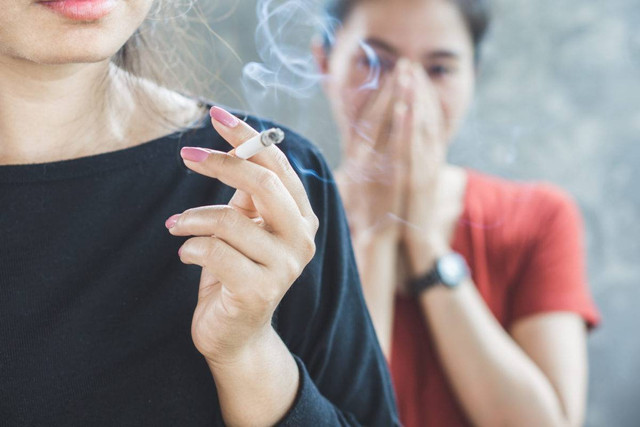Tentang KamiPedoman Media SiberKetentuan & Kebijakan PrivasiPanduan KomunitasPeringkat PenulisCara Menulis di kumparanInformasi Kerja SamaBantuanIklanKarir
2025 © PT Dynamo Media Network
Version 1.103.0
Konten dari Pengguna
The Unseen Epidemic: Protecting Our Rights from Passive Smoking and Vaping
9 Desember 2024 12:20 WIB
·
waktu baca 5 menitTulisan dari Fairuzah Nazhifah Gibrata tidak mewakili pandangan dari redaksi kumparan

ADVERTISEMENT
Imagine walking through a crowded street in Indonesia, breathing in the air thick with toxic fumes from cigarettes and e-cigarettes. You’re a non-smoker, but you have no choice but to inhale the harmful chemicals in the air. This is the harsh reality faced by millions of Indonesians—passive smokers and vapers who are exposed to dangerous emissions without their consent. It's a silent epidemic that threatens their health and violates their fundamental rights to clean air, good health, and a safe environment.
ADVERTISEMENT
In Indonesia, smoking and vaping are deeply ingrained in the culture, and the industry surrounding them is one of the largest in the world. With little regulation in place and the prevalence of smoking in public spaces, it has become normal to see people lighting up in crowded streets, restaurants, and even near schools. This normalization not only jeopardizes public health but also perpetuates a cycle of harm that impacts non-smokers and the future of the nation.
While individuals may choose to smoke or vape, those around them have no choice but to inhale the dangerous byproducts. Secondhand smoke contains over 7,000 chemicals, many of which are toxic, and around 70 can cause cancer. It is responsible for approximately 600,000 premature deaths globally each year, and Indonesia is no exception. Nearly 70% of men in Indonesia smoke, but it’s not just smokers who are at risk—it’s everyone around them.
Vaping, often marketed as a safer alternative, is not without its risks. E-cigarette aerosol can contain nicotine, ultrafine particles, and toxins known to cause cancer. The rise in vaping in Indonesia, especially among youth, brings new concerns about the long-term health effects of passive exposure. The combination of both smoking and vaping exposure is contributing to an alarming rise in respiratory diseases, cancer, and other health issues, threatening not just smokers but also those who are forced to breathe in secondhand smoke or aerosol.
ADVERTISEMENT
Beyond physical risks, passive smokers and vapers endure emotional and psychological distress. Witnessing loved ones struggle with nicotine addiction can cause stress, anxiety, and feelings of helplessness. In Indonesia, smoking is not just an individual choice but often a cultural norm, making it even harder for family members, particularly children, to advocate for smoke-free environments. This creates an environment where many people—especially young children—are trapped in situations where their health is compromised by the habits of those they care about.
Growing up in Indonesia, I witnessed firsthand the peer pressures young people face when it comes to smoking and vaping. Despite strict school policies, some students secretly smoked or vaped, believing it made them appear "cool" or because they were addicted. I, too, was reluctant to report these incidents due to the fear of social exclusion. This experience highlights the challenges individuals face in confronting such behaviors, even when they infringe upon others' rights to a healthy environment.
ADVERTISEMENT
Smoking and vaping perpetuate a harmful cycle that extends beyond the individual user. In Indonesia, the normalization of these habits is especially concerning, as it continues to grow among younger generations. Indonesia has one of the highest rates of smoking among young people, with approximately 9.1% of adolescents aged 10–18 smoking in 2018. The rise of vaping among youth adds to this troubling trend. Adolescents are particularly vulnerable to addiction, and their exposure to secondhand smoke or aerosol violates their rights to clean air and good health. The consequences of this are not limited to just one individual—they ripple through families, communities, and entire societies, continuing a cycle of harm for generations to come.
ADVERTISEMENT
Addressing passive smoking and vaping requires collective action, not just government regulation. In Indonesia, smoking is widespread, but the enforcement of smoke-free zones is weak. Cigarettes and e-cigarettes are sold openly in supermarkets and public spaces, normalizing these habits. To address this, we need to:
1. Implement Designated Smoking Areas: Establish proper smoking rooms in public spaces to minimize exposure for non-smokers.
2. Raise Public Awareness: Launch campaigns to educate the public on the dangers of secondhand smoke and promote smoke-free environments.
3. Strengthen Tobacco and E-Cigarette Regulations: Restrict the sale and advertisement of smoking products, especially in places frequented by youth.
However, regulation alone isn’t enough. Individuals must also take responsibility by:
ADVERTISEMENT
1. Being Mindful of Others: Smokers and vapers should choose areas that won’t affect non-smokers.
2. Changing Social Norms: We must shift the culture to see smoking in public as a shared responsibility, not just a personal choice.
It’s time to recognize that passive smoking and vaping violate the basic rights of others—the right to clean air, good health, and a safe environment. We must stop prioritizing personal choices over collective well-being. By fostering awareness, supporting cessation programs, and advocating for stricter policies, we can protect the health of all Indonesians, especially the most vulnerable. Let’s work together to create a future where everyone can enjoy a smoke-free environment, ensuring healthier lives for our children, our teens, and the future of Indonesia.
ADVERTISEMENT

